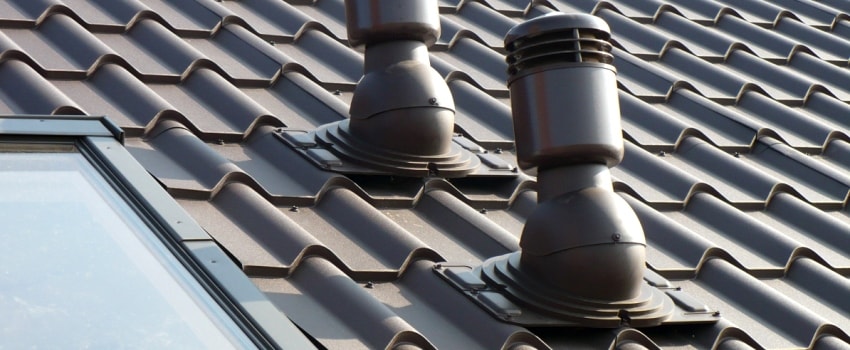Installation of a fan pipe in a private house is done to equip the sewage system with a gas vent device. How mandatory is a fun pipe in a private house is a debatable question. SNiP for internal sewerage networks allows the absence of ventilation devices for the discharge of gases accumulating in the sewer system through the roof for one-story houses.
Content
When a sewer fan pipe is needed in a private house
Sewerage movement is associated with gas generation processes. The rarefaction of gas formations occurs when runoff of a liquid medium along a vertical riser. The resulting thrust is partially accepted by siphons passing water through themselves. However, with the simultaneous discharge of a large volume of liquid from several points (shower, toilet, sink, etc.) in the siphons and piping system, a vacuum is possible.
At the same time, the lower points of the sewage system become a source of the spread of unpleasant odors through plumbing fixtures inside the premises. It is worthwhile to install a fan pipe even in a one-story private house, at least in order to avoid such volley (one-time) emissions of sewer gases with persistent unpleasant odors.
To install a fan pipe for individual home ownership with an autonomous sewer system is necessary in the following cases:
- in a one-story building, several bathrooms are installed;
- in a two-story or three-story residential building, bathrooms are equipped at least on each floor;
- the dwelling is equipped with several risers of small diameter (usually 50 mm);
- there is a facility that simultaneously discharges a very large volume of wastewater into the sewer system, for example, a swimming pool or a jacuzzi;
- with the location of the sewer tank, septic tank or drain pit at a distance from the residential part, not exceeding ten meters.
Important! Regardless of the type of sewer system, gravity or forced, a sewer pipe is necessarily installed with insufficient slope of the sewer pipes, especially near the building itself.
Sewerage in a private household can be equipped without a fan pipe by consulting with experienced construction specialists. In any case, when deciding whether to install a fan pipe in a private house, it is worth making simple calculations on your own.
The cross section of the sewer pipe is usually 110 mm. The diameter of the toilet bowl drain is 70 mm, the drain from the bathroom goes through a pipe with a diameter of 50 mm. Therefore, with the simultaneous use of several plumbing devices in the house, one of which will be the toilet, a volley discharge of gas formations from the sewer system into the room becomes quite possible.
Principles of installing a fan pipe in a private house
Before installing the fan pipe in a private house, you should take into account the requirements established by SNiP. Based on them, the installed ventilation system must meet the following conditions:
- horizontal pipes in the direction of movement of sewer gases are laid with a slope of at least 0.02 percent;
- a change in the direction of the fan pipes is permissible exclusively above the point of connection to the riser of the latest plumbing equipment;
- the diameter of the fan pipe in a private house should be equal to the diameter of the riser used for installation, or be large. Narrowing is unacceptable, regardless of what material it is decided to use for work;
- when connecting several pipes, the fan tee is mounted at an angle of 45º or 135º in the direction of gas movement;
- changing the direction of fan ventilation is allowed to be carried out exclusively by using an outlet installed at an angle of 135º;
- when plumbing is already installed, a tap is used to connect to the riser of the toilet bowl with a joint seal with ring-shaped gaskets;
- the horizontal distance from the installed system to the windows should be at least four meters;
- the sewer ventilation system is displayed separately from the chimney and the general ventilation on the leeward side;
- the end of the fan pipe is discharged, as usual, next to the roof ridge, at a distance of 0.3-0.5 m from it, which allows for unhindered discharge of unpleasant odors into the atmosphere;
- the outlet height of the exhaust part of the riser depends on the type of roof - 0.3 m for a flat and 0.5 m for a pitched one. If any structures are installed on the roof, then the exhaust part of the riser is made three-meter;
- it is undesirable to install a windshield over the exhaust part, since in winter the frost formed as a result of condensation will block the ventilation channel;
- installation of a baffle is recommended exclusively for areas with a warm climate;
- the lower part of the fan pipe to enhance traction, it is customary to place the room warmer, and the upper, respectively, in the colder.
Compliance with the stated requirements will allow to make ventilation of the sewer system without problems.
How to choose the material, dimensions and diameter of the fan pipe
The design can be made of metal (copper or cast iron) or polymeric materials.
Copper elements, with all their attractiveness and environmental safety, are too expensive and are not very durable.
Cast iron products have been used traditionally, guaranteeing durability. The disadvantages of cast iron include:
- relatively high cost;
- susceptibility to corrosion, which, among other things, gives the visible parts of the system far from an aesthetic appearance;
- tendency to clog.
Note! In cast-iron pipes, the accumulation of drain residues occurs rather quickly, which affects the passability of the riser. Therefore, you need to think in advance how to clean them.
The undoubted advantages of cast iron products:
- increased strength;
- durability;
- good soundproofing properties to reduce the noise generated by the masses moving along the riser.
Products made of polymeric materials have virtually replaced all others, since they:
- not affected by corrosion processes;
- chemically inert with respect to aggressive working environments;
- strong;
- durable
- have increased throughput, which is facilitated by the special smoothness of the inner surface, to which deposits do not stick;
- light
- quick and easy to install.
The unacceptable soundproofing properties of plastics can be improved by using special pads or windings that mask noise.
The choice of the size of the fan pipe is dictated by the height of the house, the shape can be:
- straight. It is installed strictly perpendicular to the toilet;
- vertical. It is used in a two-story (and higher) house, where two toilets (and more) are installed;
- angular. They are used for non-standard internal layout of the house.
As for the diameter, experts recommend the use of the most common - 110 mm.
Installation of fan pipe
Having resolved doubts about whether a fan pipe is needed in a private house, they proceed to the design process. They proceed with the installation, having prepared all the required tools and materials.
If a fan pipe was previously installed in the house, then you should start by dismantling it. Cast iron pipelines must be disassembled with extreme caution. At the same time, it is advisable to resort to the help of qualified specialists. Dismantling is carried out after disconnecting the riser. Plastic structural elements are thoroughly cleaned.
Installation of a new system begins with the preparation of a hole for installation, the stiffening point at the bottom of the main riser, where the foundation is located, is cleaned. For bonding, gaskets or o-rings are used, which, when laying underground, it is customary to wrap with a sealant or enclose in a box. A rubber gasket is inserted into the bell, then a tee. At a cut piece of pipe of the required length, the edge is smoothed out, lubricated with sealant and inserted into the tee.
Reliable fastening allows to reduce the vibrations caused by passage of drains, and to reduce the likelihood of breakdowns. It is recommended to mount it with metal clamps screwed to the load-bearing wall. The choice of metal clamps is explained by the ability to use them to adjust the position of the entire structure. Upon fixing, pipes are laid to plumbing devices. Placing siphons between them will make it possible to block the spread of unpleasant odors due to water standing in them.
The pipe, which will be displayed on the roof, is inserted into the tee, into the vertical hole. Soundproofing can be achieved with mineral wool or foam. A higher level of sound insulation is achieved using automotive soundproof materials, a vibroplast or isotone made of low density polyethylene.
Important! Installing a non-return valve inside or outside will not only prevent the return of gases, but will also prevent rodents from entering the room.
For outdoor installation, the flaps of the non-return valve are turned towards the plumbing devices. A visor is installed above the pipe.
Check Valve Installation
The check valve is recognized by specialists as an absolutely necessary element of ventilation of an autonomous sewer system of a private house. Its design is set in such a way as to be in relation to the movement of gases on the oncoming path.
The check valve has several roles:
- control of incorrectly performed pipe slope;
- protection against the movement of gas formations in the opposite direction;
- prevent foreign objects and suspended particles from entering the ventilation system;
- protection against the penetration of insects and small rodents, birds, etc.
Check valves are available for both indoor and outdoor installation. Models of check valves for indoor installation allow you to clean the inner surface of the fan pipe from plaque, greasy and oily deposits.
The installation of a cylindrical check valve is carried out in a discharge pipe or through an adapter. The valve cover opens when water is drained from the toilet bowl, then it returns with a steel spring to its original position, without passing back the fecal matter. The tightness of the connection of the non-return valve with the pipes is ensured by rubber rings.
Plumbing devices are equipped with exhaust pipes with a bend, in which there is a layer of water that acts as a water seal, preventing the penetration of gas formations into the interior of the house. Volley (one-time) discharge of sewage creates a vacuum in the sewer system, threatening the breakdown of hydraulic seals.
In this case, gas formations will be squeezed out of the sewer system through the drain holes into the premises. Installation of the fan pipe allows maintaining the pressure in the system at a constant level by drawing in atmospheric air. And under normal conditions, gas formations are removed to the atmosphere through the ventilation duct of the sewer system.












